
What Is Repurposing Content? The Ultimate Guide For 2025
In today’s marketing landscape, you have to use various marketing channels to reach customers and stay ahead of the competition. But what if you’re a small business that doesn’t have the resources to launch campaigns for every communication channel? Or if you’re running out of content ideas?
This is where repurposing content can help you. Instead of taking time to create different types of content, you can focus on delivering the same content but in a different format.
In this article, you will learn what content repurposing is and why it’s essential to any content marketing strategy. You’ll also learn eight creative ways to repurpose your content. Let’s dive in!
What Is Content Repurposing?
Content repurposing is the process of taking existing content, such as a long-form blog post, and transforming it into another format for publication on different channels. The goal is to transform it into a new content format that is more engaging for a specific audience or serves a different purpose.
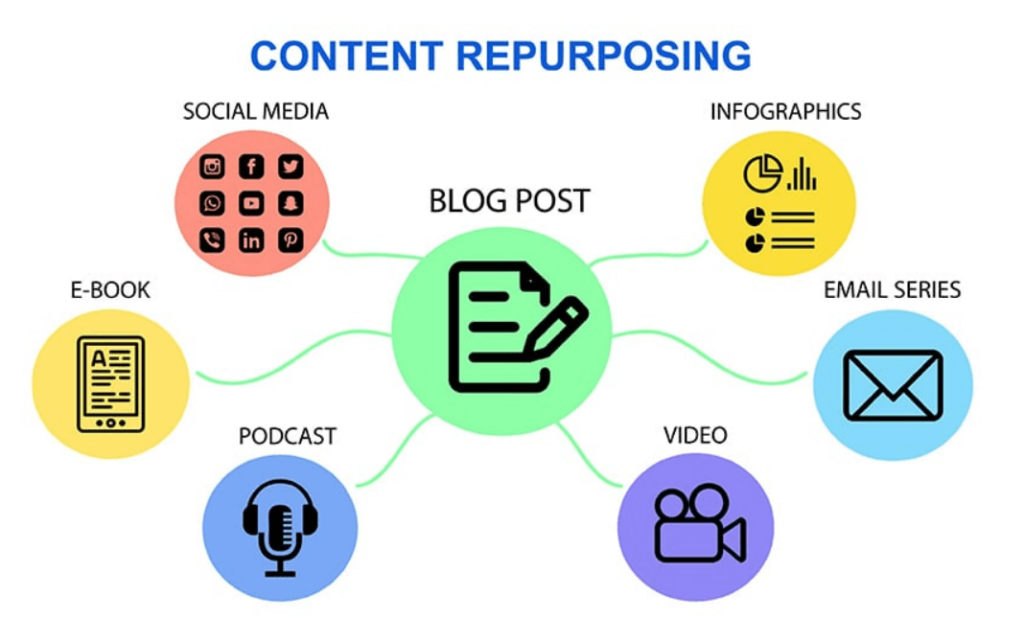
Repurposing content can take many forms. For example, a blog post or white paper can be repurposed into an infographic, a social media post, a video, a podcast episode, an email series, and more.
However, content repurposing works best if you use updated or evergreen content. For example, you can update the article that showcased industry statistics and reupload it. Or, you can use content that never goes out of style, like how-to guides, articles, and case studies that cover the basics.
You should know that repurposed content is not the same as plagiarized content. However, repurposed content aims to create a new piece of content based on your own old resources. Taking someone else’s blog post and transforming it into a social media post is plagiarism.
It’s also worth noting that guest posts or content republishing isn’t content repurposing. If you publish an article on your blog and want to redistribute it on different platforms, it will still be published as a blog post. In content repurposing, you convert the content into a different format.
What Are the Benefits of Repurposing Content?
Repurposing content is an effective strategy marketers use to attract and convert more people. Here are the most significant benefits of repurposed content:
Improved SEO
Publishing optimized content in different formats can give you an advantage over the competition when it comes to search engine optimization. It gives you more access to search real estate for targeted keywords. As a result, you get increased organic traffic.
Also, if you use valuable resources in multiple forms, you can link them to each other. This can help improve your SEO rankings. High-quality, valuable content is also sharable and can allow you to gather backlinks from different sites.
What’s more, using content that previously proved successful can ensure high SEO performance of the new content piece. You’ve already done keyword research and found content gaps for the original content, so optimizing the repurposed piece is much easier. If you’re unsure what pieces perform best, use Google Analytics to see which blog posts bring the most traffic.
Reinforcing messaging
Repetition is vital in marketing. You need consistent communication with your audience to create a strong brand image. Instead of addressing a topic only once and allowing it to fade into the archives, reuse your articles to consistently deliver your message to your audience.
This approach is particularly effective when you begin with high-value, authoritative content, as it creates opportunities to reinforce your message in unique ways. By repurposing your content, you ensure your message remains visible and impactful, maximizing its reach and resonance.
Plus, if you have various pieces of content on the same topic, you can be recognized as an authority on the matter. This is especially true if you make engaging, high-quality content.
Time and cost savings
With content repurposing, it takes just one great content idea to produce multiple engaging content pieces. You can change minor details to suit a specific format or channel without much time and effort.
Repurposing content also allows you to optimize and recycle your best-performing content. So, you can leverage the strengths of your high-performing content and extend its lifespan, saving time and resources on creating entirely new content. Ultimately, repurposing content can help streamline the content creation process and make planning easier.
8 Ways to Repurpose Your Content And Increase Conversions
You can find creative and entertaining ways to give new life to old content pieces. Here are eight ways to repurpose your blog content:
1. Create an email series
Here’s one of the top ways to repurpose content: craft a newsletter containing the most interesting information from your blog post. You can even take a series of related blog posts and turn them into an email series. This allows you to provide valuable content to your target audience while nurturing them along the buyer’s journey.
In your emails, don’t forget to provide a link to the original posts for more detailed information. This way, you also drive traffic to your blog.
If you have trouble creating copy that matches an email format you can use AI writing tools. It can create a summary of what you already wrote. You just need to insert the right prompts.
Check out the email example below by Sweetkick to get inspired:
Subject line: Sample schedule for a low-sugar day

Looking for a top-notch email marketing platform to automate your email sequences? Sign up for a free Moosend account and explore our features.
2. Create a YouTube video
YouTube is a great medium for long-form video content. It had a significant reach with at least 2.527 billion users around the world in April 2023. Creating a YouTube video is a great idea if you have a blog post topic that needs more explanation. You can easily repurpose and turn a blog post into a video script.
In YouTube videos, you can use a more conversational tone and visual content to help explain more advanced topics. A video with some interesting graphics could really pull the viewer in.
Backlinko is known for turning blog posts into videos. Brian Dean, the founder of Backlinko, originally published an on-page SEO blog post in 2013. The article was made into a YouTube video titled “On Page SEO – 9 Actionable Techniques That Work” later on.
So far, the video has almost 300,000 views.
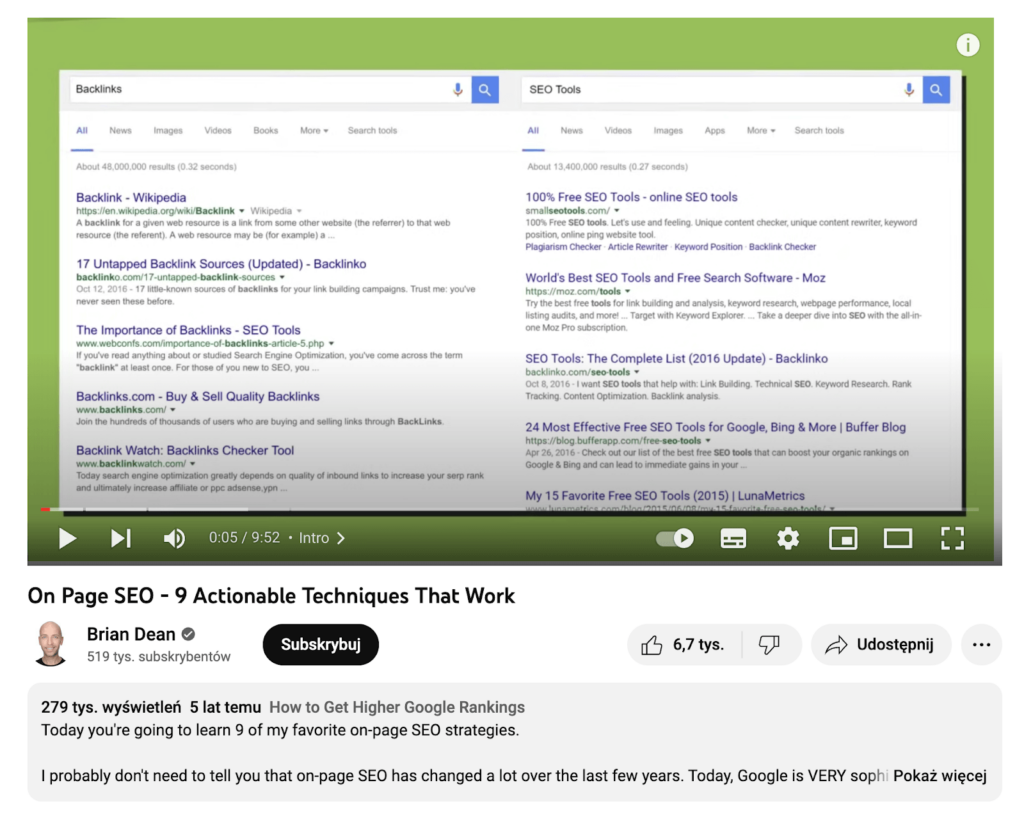
Alternatively, if you already make videos, you can convert them into actionable blog posts. For example, Moz consistently creates Whiteboard Friday videos that shortly explain SEO basics. They provide a visual demonstration of the topic and engage their audience at the same time.
Those videos are distributed individually, but they’re also turned into blog posts with video transcriptions. This is great for optimization and organic traffic.
3. Make infographics or slidedecks
If you have an in-depth blog post covering statistics or metrics from your industry, you can create an infographic. Users love visuals, so creating a summary or listicle of the most hard-hitting statistics from your posts can result in an engaging, digestible piece of content.
You can add these infographics to your blog post or republish them as social media posts. Since they’re visuals, they’re easier to share. When people share your infographics, you can reach even more people. Here’s an example by SproutSocial:
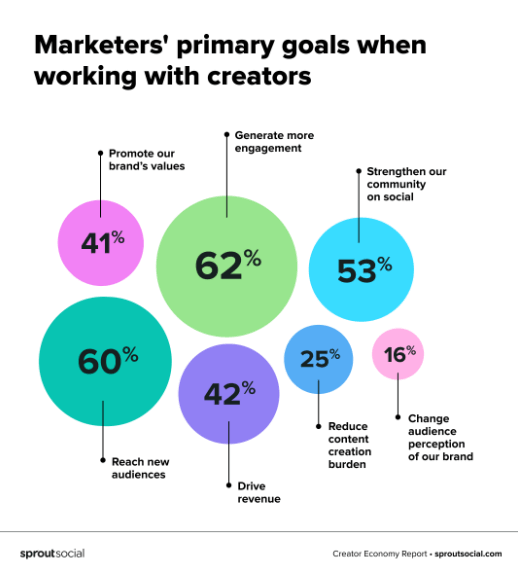
Infographics are also an effective way to obtain backlinks. Content creators typically link to infographics in their blog posts or social media, so it’s a great way to get exposure for your brand.
What’s more, infographics are easier to make than they seem. Once you have the statistics ready, you can use Canva or Adobe Sparks to put it together. Graphic design tools like these already have premade templates you can customize to suit your brand. You can also use SlideShare to create slide decks for presentations.
4. Create a podcast episode
Podcasts are extremely popular, with 464.7 million listeners in 2023. Repurposing content into podcasts can help you reach a wider audience.
You can take the main points from your long-form content and turn them into a script for a podcast episode. The headings can be chapters that divide the episode and give it a sense of rhythm. You can expand on the most interesting ones and add stories and anecdotes. This will give your podcast a more conversational tone.
You can also leverage remote podcasting software to invite guests, such as thought leaders, facilitating in-depth discussions on the topic and delivering additional value to your audience.
A great content repurposing example is the Internet Business Mastery podcast. The hosts, Jeremy and Jason, also maintain their own separate blogs. As part of an experiment, they converted some of these blog posts into audio format and uploaded them to their podcast.
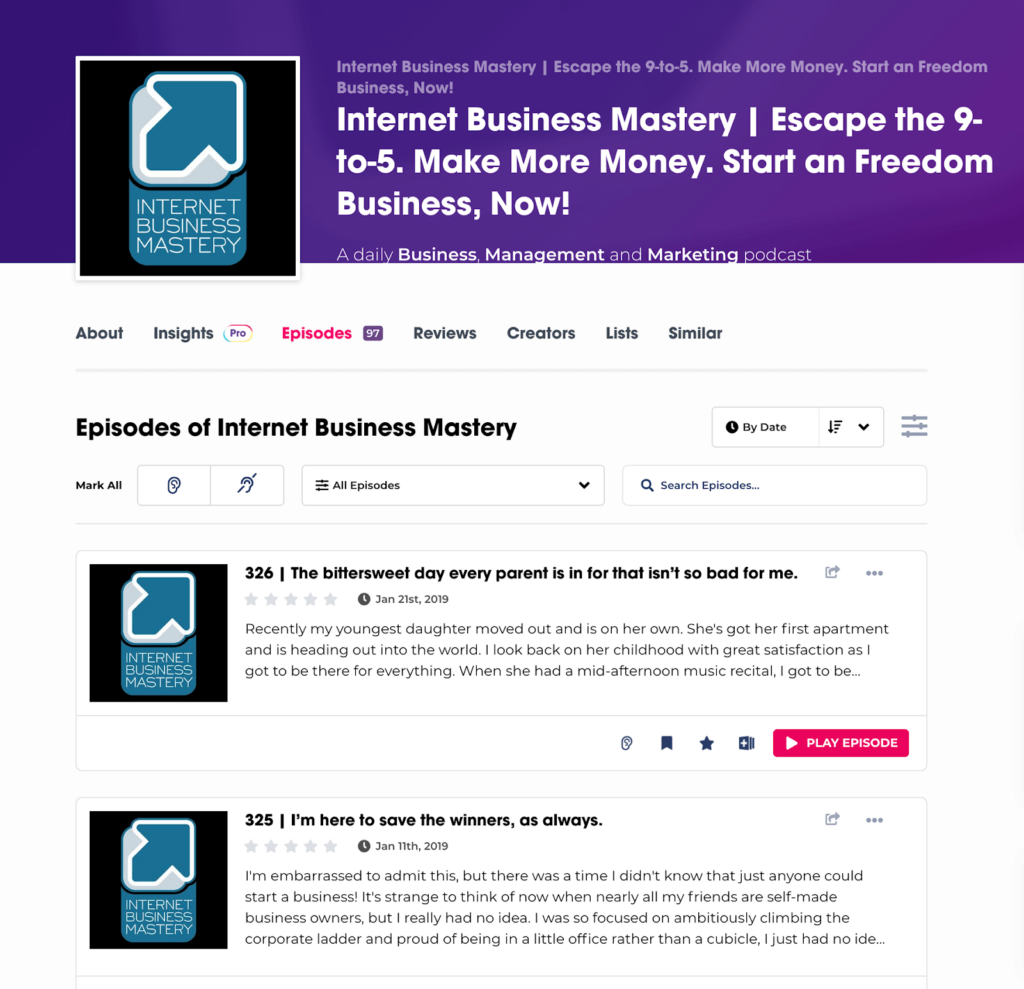
Surprisingly, these audio blogs experienced a significant boost in downloads, ranging from 60% to 100% more than their regular podcast episodes.
5. Write an eBook
An eBook is a great way to share your expertise with the world. You can easily convert a blog post tutorial into an eBook as they are both long-form formats. The eBook can be a more in-depth discussion of your original content, while the blog post focuses on the key points.
To write your eBook, then, you wouldn’t need to start from scratch. All you need to do is your most interesting and best-performing articles and edit them into an eBook format. Expand the most complex topics so you give your eBook audience additional value.
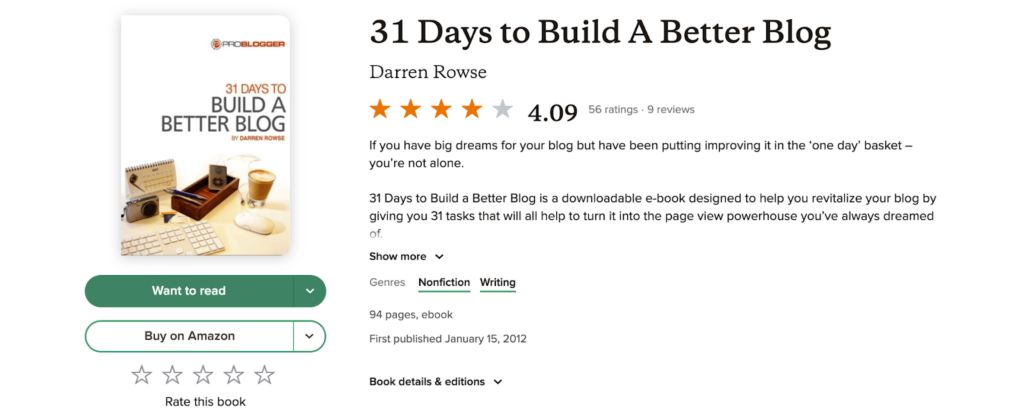
Here’s a great example of blog content repurposed into an eBook. Darren Rowse, the founder of ProBlogger, transformed his “31 Days to Build a Better Blog” and started selling the eBook.
This is a great strategy because, if all goes well, you earn, not just from your blog post, but from the eBook, too. Besides, you expand your online presence and boost your authority in that specific niche.
6. Publish social media content
Repurposing already-existing blog posts into social media posts allows you to reach new audiences on the social media platform. It can also reinforce your messaging.
The other good news is that if you can write engaging blog posts, you can easily turn them into captivating social media content for LinkedIn, Tiktok, etc. You just need to take the most interesting pieces of your blog post and highlight the main takeaways on your social media post.
For example, Hubspot published an article “What Will Influencer Marketing Look Like in 2023?” where they included vital influencer marketing statistics.

They turned this part of the article into an Instagram post. Here’s how it looked like:
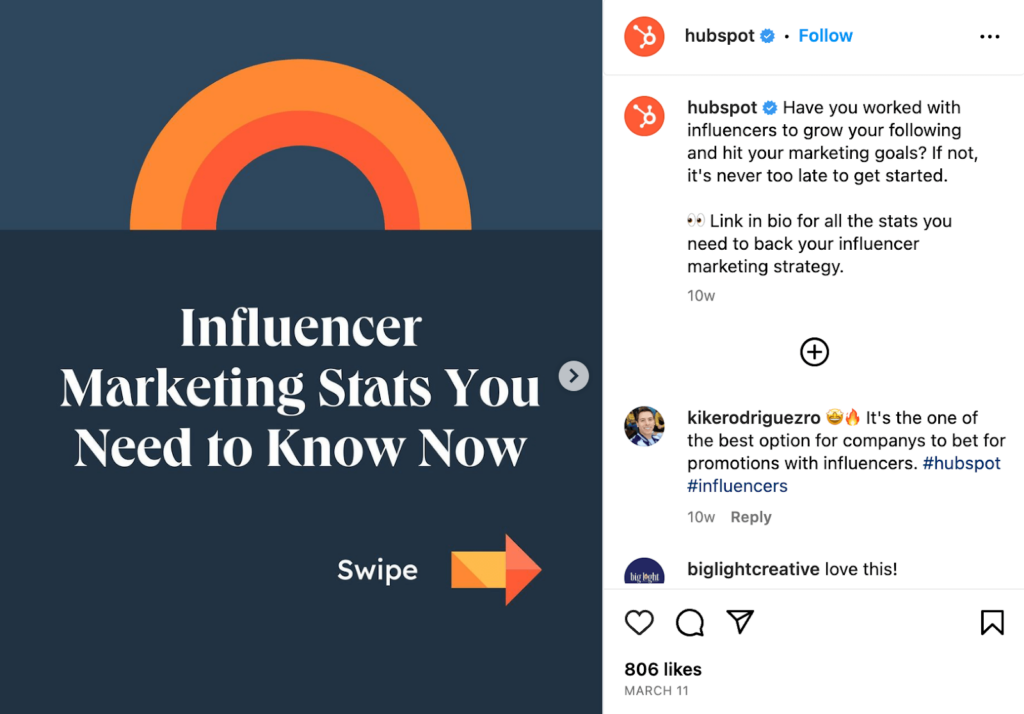
You can also get the most prominent quotes in your blog posts and turn them into social media graphics. If you take the most impactful quotes from guests or experts, you can encourage people to read the entire blog post. So, don’t forget to leave a link to the original blog post on your social media post.
Besides, social media is a great channel to publish graphics. On social media, people can easily engage with your brand and share the most memorable content. If you post high-quality content, getting more Instagram followers and Facebook friends is also easy.
Keep in mind that each post should, however, match the social platform you want to publish it on. For instance, longer infographics are great for Pinterest. Meanwhile, images with one or two statistics are a good fit for Twitter or Instagram.
To create aesthetically-pleasing graphics, you can use tools like Canva or Adobe Spark. If you’re unsure what kind of background to use, you can utilize the images from your old blog post. This way, your audience will know the blog post and the social media post are related.
7. Create a webinar or online course
If your blog is full of helpful how-to posts, it’s not too difficult to turn them into study material for an online course or webinar. This allows you to provide additional value to your audience while also establishing yourself as an authority in your field.
There are many benefits to launching a course or a webinar. First, you can gain access to your audience’s email addresses. You can do this by giving access to the online course or webinar only to people who willingly give you their email addresses. These email addresses can help you build your email list.
Second, you can effectively grow your community. You can create a Facebook group for students to share information from the course or webinar and network, for example.
If you have a lot of blog content on the topic, it can be much easier to create an online course or a webinar presentation. Read your original blog post and create an outline based on what you read. Or, if you used an outline to write your blog post in the first place, you can use that as your webinar or online course structure. The points in the outline can serve as the specific lessons that comprise your online course or webinar.
There are also several tools online that can streamline the process of creating an online course, like Teachable and Podia.
8. Make an online quiz
Quizzes are great for captivating users and providing personalized results. They also encourage social sharing. This interactive experience not only enhances user engagement but also encourages audiences to spend more time on your website or other platforms. The result is that you increase your brand’s overall exposure.
So, why not use your blog post as your basis to create an online quiz? When creating an online quiz, just leverage the expertise and insights shared in your blog post to craft a set of thought-provoking questions. The goal is to create questions designed to test the knowledge of your audience.
This is a strategy BridghtEdge follows. After reading many of its blog posts, for instance, you can take BrightEdge’s Digital Marketing Quiz:

The good thing about quizzes is that you can use them to know more about your audience, too. You can include some questions on audience preferences. For instance, you could ask what specific digital marketing topic they’d be interested in learning about. You can then create a new blog post discussing this preferred subject, and, subsequently, create another quiz testing their knowledge on the matter.
There are many tools that can help you build and host your quiz online. Some of the most popular options include Interact and Typeform.
The Takeaways
Repurposing content enables you to maximize the reach and impact of your content. After all, you’re publishing the content on multiple platforms. Also, you can improve SEO, increase online authority, reinforce brand messaging, and save time and costs.
You learned ways you can repurpose your old blog posts. You can transform them into YouTube videos, infographics, podcasts, eBooks, and social media posts. You can also repurpose them into a webinar or an online course, an email series, or even an online quiz.
With repurposed content, you can ultimately strengthen your brand presence and reap the best results. Good luck!



 Published by
Published by

 Published by
Published by